PERC Solar Panels Market Research, 2032
The global perc solar panel market was valued at $140.4 billion in 2022, and is projected to reach $304.9 billion by 2032, growing at a CAGR of 8.2% from 2023 to 2032. Passivated Emitter and Rear Contact Solar Panel are sophisticated types of photovoltaic solar panels that can produce more than 20% more power than ordinary photovoltaic panels. The rear surface of the solar cell in a PERC panel is passivated, which means it has been chemically treated to prevent electron and hole recombination. This permits more light to be absorbed by the solar cell, increasing energy generation efficiency. The passivation layer on the rear of the cell helps to reflect photons that pass through the cell's front side. This improves the overall conversion efficiency of the solar panel, as more sunlight is effectively utilized.
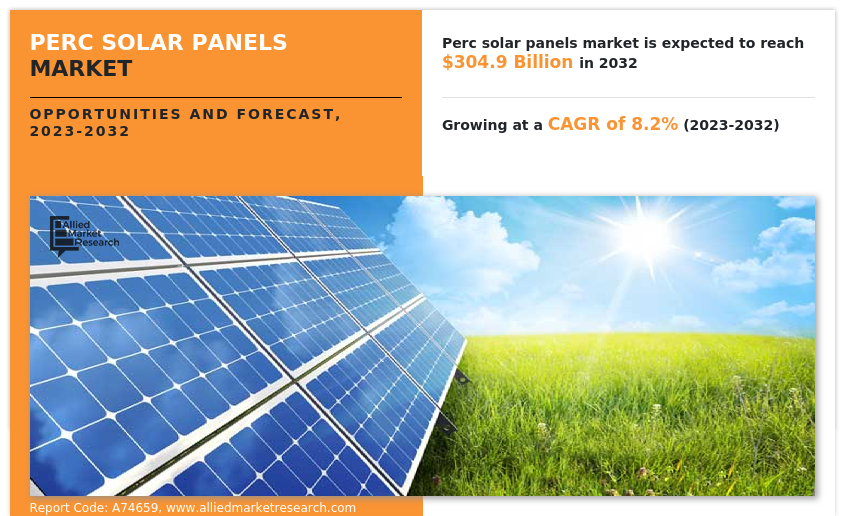
PERC solar panels have higher conversion efficiency compared to traditional solar panels. The passivation layer on the rear side of the PERC solar cell helps to reduce the recombination of charge carriers. This boosts light absorption within the cell, allowing for more efficient sunlight conversion into energy. PERC panels may capture a larger fraction of the solar spectrum, including low-intensity and indirect sunlight, by decreasing electron and hole loss. By maximizing power output, PERC panels offer greater energy production potential, leading to improved return on investment for customers. Furthermore, PERC solar panels can deliver more power output per unit area. This characteristic is advantageous for installations with limited space, as it allows for the generation of more electricity from a smaller footprint. The higher power density of PERC panels also reduces the overall balance of system (BOS) costs, including components like racking, wiring, and installation labor. Although PERC panels typically come at a slightly higher initial cost compared to traditional solar panels, their increased efficiency can help offset this difference. The higher power output per panel reduces the number of panels needed to achieve the desired energy output, resulting in potential savings in installation and BOS costs. Over the lifetime of the system, the improved performance and energy yield of PERC panels can provide a favorable return on investment. The increased efficiency is one of the major growth drivers of the PERC solar panel market.
The PERC solar cells require additional manufacturing steps compared to traditional solar cells. These include the formation of a passivation layer on the rear surface of the cell, which enhances the cell's ability to capture and convert sunlight into electricity. The deposition of this passivation layer adds complexity and cost to the manufacturing process. Moreover, the passivation layer in PERC solar cells typically consists of additional materials such as aluminum oxide or silicon nitride. These materials help reduce recombination losses and improve cell efficiency. However, these materials can be more expensive compared to the materials used in traditional solar cells, adding to the overall manufacturing cost. PERC technology is relatively new compared to traditional solar cell technologies. The development and optimization of PERC solar cells require significant R&D investments. These costs are often reflected in the higher initial prices of PERC solar panels.
The technological advancements have enabled higher conversion efficiencies in PERC solar cells. PERC technology utilizes passivated rear contacts to reduce recombination of charge carriers, resulting in improved cell efficiency. Higher efficiency means that more sunlight can be converted into electricity, leading to higher power outputs and better overall performance of PERC Solar Panel Market. Moreover, manufacturers have focused on improving the durability of PERC solar panels through technological advancements. This includes developing better anti-reflective coatings, enhanced protection against environmental factors like moisture and UV radiation, and increased resistance to potential-induced degradation. These advancements make PERC panels more reliable and long-lasting, appealing to customers looking for a sustainable and low-maintenance solar solution. Furthermore, technological advancements have also focused on improving the overall reliability of PERC solar panels. This includes reducing the risk of potential degradation mechanisms, such as light-induced degradation (LID) and potential-induced degradation (PID). Improved reliability ensures that PERC panels can consistently deliver high-performance over their operational lifetime, making them a dependable choice for customers. Technological advancements have made it possible to scale up the production of PERC solar panels. With improved manufacturing processes and increased automation, manufacturers can produce PERC panels at larger volumes, leading to economies of scale and cost advantages. The scalability of PERC technology has contributed to its wider adoption and market growth. These major factors are projected to offer growth opportunities for PERC solar panel market forecast players during the forecast period.
The key players profiled in PERC solar panel market trends report include Sunnova Energy International, Inc., Jinko Solar, Canadian Solar, SolarEdge, First Solar, Inc., Trina Solar, JA Solar Holdings Co. Ltd., SunPower Corporation, Wuxi Suntech Power Co., Ltd., and REC Solar Holdings AS. Investment and agreement are common strategies followed by major market players. For instance, in December 2020, Soleos, a renowned EPC service provider, introduced its unparalleled solar panel, ANTARES BI 144. The company acknowledged the recent advancements and developments in the energy sector, and it launched this highly sought-after solar panel module. The product that was launched offered increased efficiency to optimize space and lower overall system costs. It fell into the mono-crystalline silicon category and featured the latest PERC Solar cells with high transmission energy. This ultra-high power module has cells measuring 182 and 212 mm.
The PERC solar panel market is segmented on the basis of type, application, mounting, installation, and region. By type, the market is divided into mono-crystalline and polycrystalline. By application, the market is classified into residential, commercial, and utility. By mounting, the market is classified into roof-top and ground-mounted. By installation, the market is classified into on-grid, off-grid, and hybrid. By region, the market is analyzed across North America, Europe, Asia-Pacific, and LAMEA.
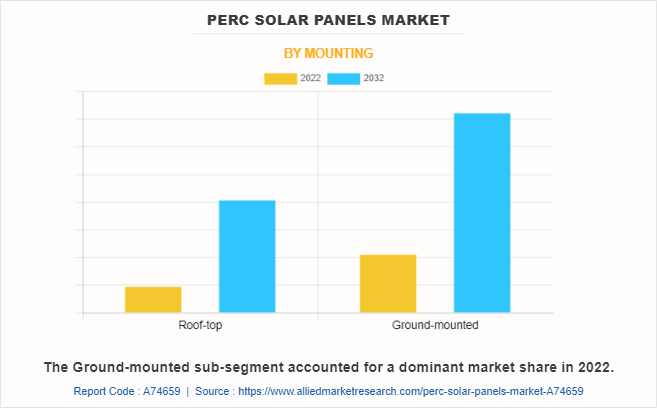
By mounting, the ground-mounted sub-segment dominated the global PERC solar panel market share in 2022. PERC technology enables higher energy conversion efficiency compared to traditional solar cells. The passivation layer on the rear surface of the cell reduces recombination, allowing more photons to be converted into electricity. Moreover, the production costs of PERC solar panels have decreased due to advancements in manufacturing processes and economies of scale. PERC cells have demonstrated improved performance under diffuse light, making them suitable for ground-mounted installations in regions with less consistent sunlight.
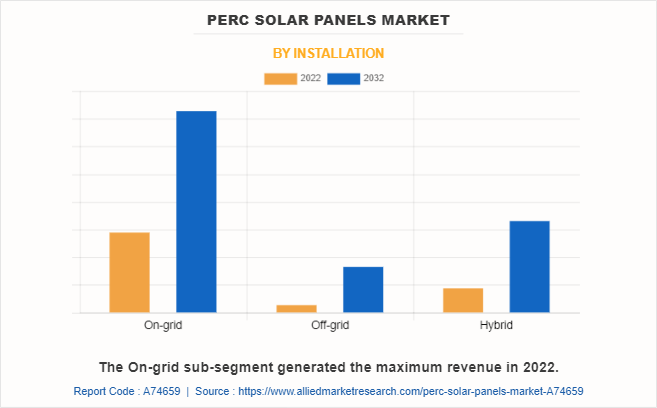
By installation, the on-grid sub-segment dominated the global PERC solar panel market share in 2022. PERC technology enhances the efficiency of solar panels by adding a passivation layer to the rear side of the cell. This passivation layer reduces electron recombination and increases light absorption, resulting in higher energy conversion efficiency. Furthermore, as the efficiency of PERC solar panels has increased over time, the cost per watt of power produced has reduced, making them a more enticing option for on-grid deployments. Numerous governments and utilities offer incentives and laws to stimulate the use of renewable energy, including on-grid solar installations. Feed-in tariffs, tax credits, subsidies, and other financial incentives that boost the economic sustainability of on-grid solar installations are examples of these financial benefits. These factors are anticipated to boost the demand for PERC solar panel market size.
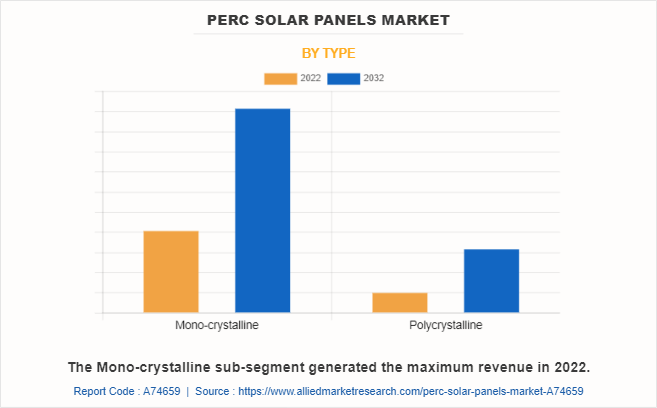
By type, the mono-crystalline sub-segment dominated the market in 2022. Mono-crystalline solar cells have higher efficiency compared to other types of solar cells, such as polycrystalline or thin-film cells. The PERC technology enhances the efficiency of mono-crystalline cells by adding a passivation layer at the rear surface, resulting in improved light absorption and conversion of sunlight into electricity. The higher efficiency of mono-crystalline PERC panels makes them attractive for various applications. Moreover, PERC technology provides enhanced performance characteristics, including better low-light performance and improved temperature coefficient. This means that mono-crystalline PERC panels can generate electricity even in low-light conditions and maintain higher efficiency at elevated temperatures. These performance advantages make them suitable for regions with varying weather conditions. These factors are anticipated to boost the PERC solar panel market growth.
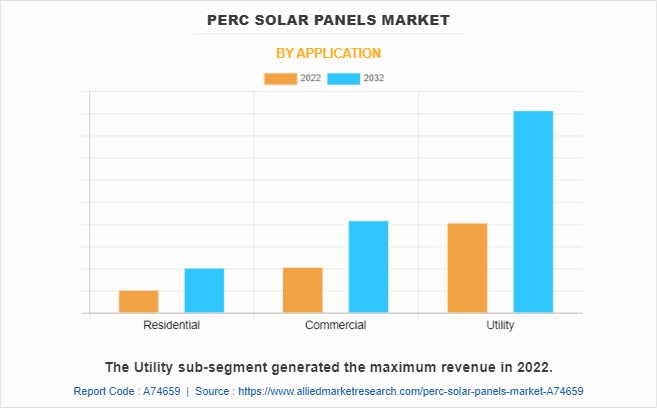
By application, the utility sub-segment dominated the global PERC solar panel market scope in 2022. When compared to typical solar panels, PERC solar panels have a better energy conversion efficiency, resulting in enhanced electricity generation. As a result, they are an appealing option for utility-scale solar projects, where cost-effectiveness is critical due to large-scale installations. PERC technology improves solar panel performance by increasing light absorption and decreasing electron recombination. This improved performance is especially helpful for utility-scale projects where energy output must be maximized. Furthermore, huge numbers of solar panels are required for utility-scale solar installations to generate considerable amounts of electricity. To fulfill the demands of such projects, PERC technology may be simply scaled up. The modular design and compatibility with existing manufacturing processes make PERC panels a preferred choice for utility-scale installations.
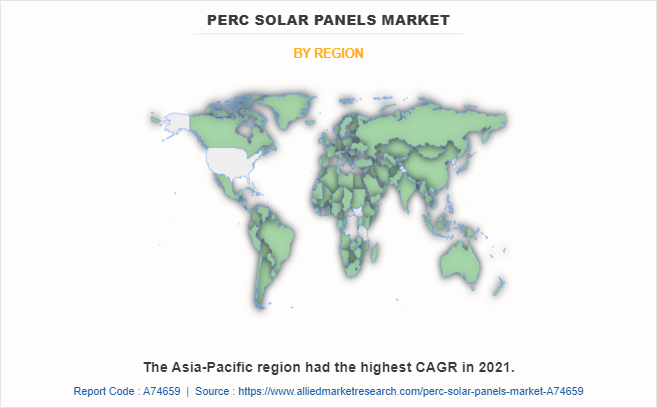
By region, Asia-Pacific dominated the global market in 2022. China has become a major producer of solar panels with PERC technology on the international market for solar energy. The majority of solar panels are produced in China and then exported to other countries. In addition, other nations in the Asia-Pacific region are now making investments in solar technology to lessen their reliance on fossil fuels. For instance, India installed 10.2 GW more solar capacity in 2021 than it did in 2022, an increase of 13.0 GW. Additionally, governments in the area are offering financial incentives and subsidies to promote the production of solar electricity, which has increased demand for solar panels, especially PERC solar panel technology. These factors are anticipated to boost the PERC solar panel market opportunities.
Impact of COVID-19 on the Global PERC Solar Panel Industry
- The COVID-19 pandemic has had a significant impact on the PERC solar panel market. The pandemic led to disruptions in the global supply chains, including the production and transportation of solar panel components. Lockdown measures, restrictions on international trade, and temporary factory closures in various countries affected the supply of raw materials and manufacturing processes, which impacted the production and availability of PERC solar panels.
- The COVID-19 pandemic caused economic uncertainty and reduced consumer and business spending. Delayed or canceled solar projects, reduced investments in renewable energy, and overall market uncertainty impacted the demand for PERC solar panels.
- Restrictions on movement and social distancing measures implemented during the pandemic posed challenges to the installation of solar panels, including PERC panels. Limited access to installation sites, shortage of skilled labor, and delays in obtaining necessary permits affected the deployment of solar projects, thereby impacting the demand for PERC panels.
Key Benefits For Stakeholders
- This report provides a quantitative analysis of the market segments, current trends, estimations, and dynamics of the PERC solar panel market analysis from 2022 to 2032 to identify the prevailing PERC solar panel market opportunities.
- The market research is offered along with information related to key drivers, restraints, and opportunities.
- Porter's five forces analysis highlights the potency of buyers and suppliers to enable stakeholders make profit-oriented business decisions and strengthen their supplier-buyer network.
- In-depth analysis of the PERC solar panel market segmentation assists to determine the prevailing market opportunities.
- Major countries in each region are mapped according to their revenue contribution to the global market.
- Market player positioning facilitates benchmarking and provides a clear understanding of the present position of the market players.
- The report includes the analysis of the regional as well as global PERC solar panel market trends, key players, market segments, application areas, and market growth strategies
PERC Solar Panels Market Report Highlights
| Aspects | Details |
| Market Size By 2032 | USD 304.9 billion |
| Growth Rate | CAGR of 8.2% |
| Forecast period | 2022 - 2032 |
| Report Pages | 290 |
| By Mounting |
|
| By Installation |
|
| By Type |
|
| By Application |
|
| By Region |
|
| Key Market Players | Jinko Solar, Sunnova Energy International, Inc., JA Solar Holdings Co. Ltd., REC Solar Holdings AS, SolarEdge, Trina Solar, Canadian Solar, Wuxi Suntech Power Co., Ltd., First Solar, Inc., SunPower Corporation |
The growing demand for PERC solar panels offer higher conversion efficiencies compared to traditional solar cells. By implementing a passivation layer on the rear surface of the solar cell, PERC technology reduces electron recombination, thereby improving overall efficiency. The demand for higher efficiency solar panels is estimated to generate excellent opportunities in the PERC solar panel market.
The major growth strategies adopted by PERC solar panel market players are investment and agreement.
Asia-Pacific will provide more business opportunities for the global PERC solar panel market in the future.
Sunnova Energy International, Inc., Jinko Solar, Canadian Solar, SolarEdge, First Solar, Inc., Trina Solar, JA Solar Holdings Co. Ltd., SunPower Corporation, Wuxi Suntech Power Co., Ltd., and REC Solar Holdings AS are the major players in the PERC solar panel market.
The ground-mounted sub-segment of the mounting acquired the maximum share of the global PERC solar panel market in 2022.
Commercial & industrial customers and solar power plant developers are the major customers in the global PERC solar panel market.
The report provides an extensive qualitative and quantitative analysis of the current trends and future estimations of the global PERC solar panel market from 2022 to 2032 to determine the prevailing opportunities.
The market for PERC technology has demonstrated enhanced performance in high-temperature environments. By minimizing the effect of temperature-induced degradation, PERC panels can maintain higher efficiency levels, making them suitable for regions with hot climates. This feature has contributed to the popularity of PERC panels in markets with high-temperature regions. This factor is estimated to drive the adoption of PERC solar panel.
Loading Table Of Content...
Loading Research Methodology...



